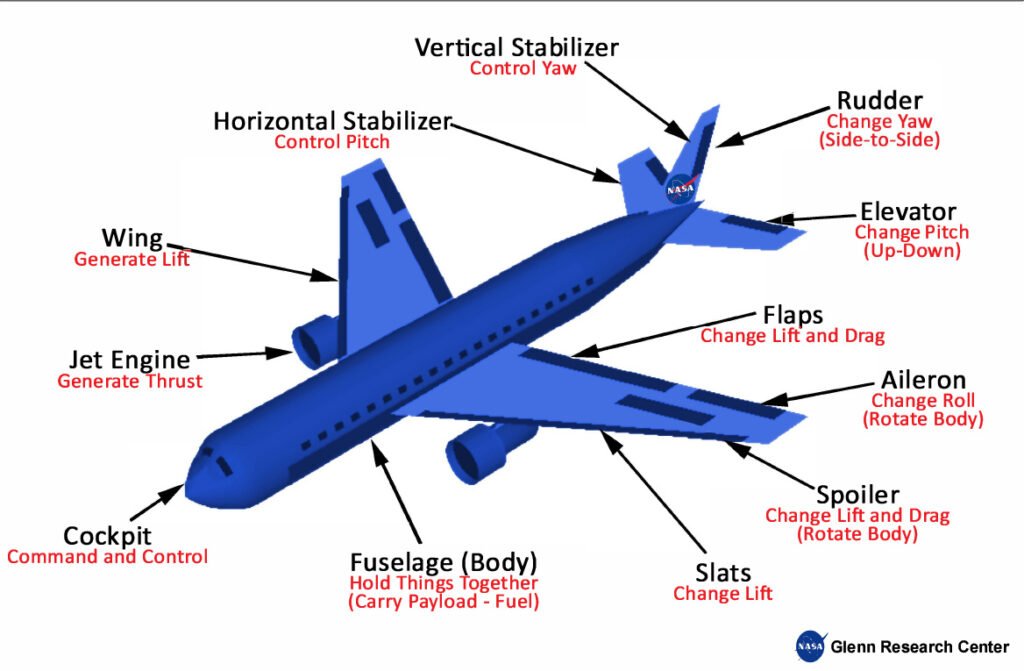Airplanes are complex machines made up of many parts, each with its own specific role in making the plane fly efficiently and safely. Below, we’ll take a closer look at the key components of an airplane and how they contribute to its overall functionality.

Fuselage
The fuselage, or the main body of the plane, holds everything together. This is where the cockpit is located at the front, with the pilots operating the aircraft. Behind the cockpit, the fuselage houses the passengers and cargo. It’s essentially the backbone of the airplane, providing structure and support for other components.
Cockpit
The cockpit is the control center of the airplane, located at the front of the fuselage. This is where the pilots sit and manage the flight. The cockpit is equipped with several key elements, including:
- Instrument Panel: Similar to a car’s dashboard, the instrument panel gives the pilot important information about the flight, the engine, and other flight conditions. Depending on the plane’s avionics, this may be presented on an interactive screen or a traditional ‘6 Pack’ of key indicators.
- Flight Controls: The cockpit includes the necessary controls to steer and operate the plane, including control sticks or yokes.
- Pilot Seats: There are typically two seats in the cockpit, one for the pilot and one for the co-pilot.
- Rudder Pedals: These pedals help control the yaw (side-to-side motion) during flight and assist with ground steering while taxiing.
- Overhead Panel: This panel houses systems that control air conditioning, electrical components, fuel, and hydraulics.
- Side Consoles: These consoles contain communication instruments and storage for documentation.
Each part of the cockpit plays a vital role in keeping the aircraft under control throughout the different phases of flight.
Wings
Wings are essential to creating the lift that allows an airplane to fly. However, there are multiple parts within the wings that help control lift and ensure a smooth flight:
- Ailerons: Located on the trailing edge of the wings, ailerons help control the plane’s roll. For example, when the pilot turns left, the left aileron moves up, decreasing lift on that side, while the right aileron moves down, increasing lift, causing the plane to roll left.
- Flaps: These are also found on the trailing edge but differ from ailerons in that they move symmetrically. Flaps are used during takeoff and landing to increase lift and reduce stall speeds at slower speeds.
- Winglets: Winglets are the upward-bent tips of wings on airliners, designed to reduce drag and improve fuel efficiency.
- Slats: Located at the front edge of the wings, slats temporarily change the wing’s shape to increase lift during takeoff and landing.
- Spoilers: Spoilers disrupt the airflow over the wing to reduce lift and help the airplane descend without gaining excessive speed.
Each of these components works together to give the airplane the necessary control during flight, especially when it comes to changing direction and altitude.
Tail (Empennage)
The tail of an aircraft plays a crucial role in maintaining stability during flight. It consists of several important parts:
- Horizontal Stabilizer and Elevator: The horizontal stabilizer prevents unwanted up and down movements (pitch) of the aircraft’s nose. The elevator, located on the horizontal stabilizer, is controlled by the pilot to raise or lower the nose of the plane, changing its angle and adjusting lift.
- Vertical Stabilizer and Rudder: The vertical stabilizer keeps the plane stable against side-to-side movements (yaw). The rudder, located on the trailing edge of the vertical stabilizer, allows the pilot to control the yaw, aiding in coordinated turns when used with the ailerons.
The tail is essential for keeping the aircraft steady and on course throughout the flight.
Engines
The engine, often referred to as the powerplant, is what gives the airplane the thrust it needs to fly. There are generally two types of aircraft engines:
- Reciprocating Engines: These engines mix air with fuel and ignite it to create combustion. The resulting gases exit the engine, spinning the propeller and creating thrust.
- Turbine Engines: In turbine engines, air is compressed, mixed with fuel, ignited, and expelled, generating thrust from the exhausted air. This type of engine is commonly found in commercial airliners and other large aircraft.
The engine’s ability to generate thrust is what propels the plane forward, allowing the wings to create the necessary lift.
Propeller
The propeller, attached to the engine, is responsible for converting the engine’s power into thrust. It operates similarly to a wing, creating a pressure difference as it spins. This pressure difference generates lift, but instead of lifting the plane upward, it propels it forward. This forward motion drives air over the wings, generating the vertical lift needed to keep the airplane in the air.
Landing Gear
The landing gear is a crucial part of any airplane, as it allows for safe takeoffs and landings. Located beneath the fuselage, the landing gear usually consists of a wheel and a strut designed to soften the impact with the ground. There are two common types:
- Tricycle Landing Gear: This configuration includes one wheel at the front and two wheels behind it, commonly seen in general aviation aircraft.
- Tailwheel Landing Gear: This has two wheels at the front of the plane and one wheel under the tail.
The landing gear can be retractable, allowing the wheels to be stored inside the fuselage during flight to reduce drag.